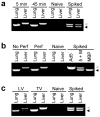A myeloid cell-binding adenovirus efficiently targets gene transfer to the lung and escapes liver tropism
- PMID: 23171918
- PMCID: PMC3764611
- DOI: 10.1038/gt.2012.91
A myeloid cell-binding adenovirus efficiently targets gene transfer to the lung and escapes liver tropism
Abstract
Specific and efficient gene delivery to the lung has been hampered by liver sequestration of adenovirus serotype 5 (Ad5) vectors. The complexity of Ad5 liver tropism has largely been unraveled, permitting improved efficacy of Ad5 gene delivery. However, Kupffer cell (KC) scavenging and elimination of Ad5 still represent major obstacles to lung gene delivery strategies. KC uptake substantially reduces bioavailability of Ad5 for target tissues and compensatory dose escalation leads to acute hepatotoxicity and a potent innate immune response. Here, we report a novel lung-targeting strategy through redirection of Ad5 binding to the concentrated leukocyte pool within the pulmonary microvasculature. We demonstrate that this leukocyte-binding approach retargets Ad5 specifically to lung endothelial cells and prevents KC uptake and hepatocyte transduction, resulting in 165,000-fold enhanced lung targeting, compared with Ad5. In addition, myeloid cell-specific binding is preserved in single-cell lung suspensions and only Ad.MBP-coated myeloid cells achieved efficient endothelial cell transduction ex vivo. These findings demonstrate that KC sequestration of Ad5 can be prevented through more efficient uptake of virions in target tissues and suggest that endothelial transduction is achieved by leukocyte-mediated 'hand-off' of Ad.
Conflict of interest statement
The authors declare no competing financial interests.
Figures






Similar articles
-
The myeloid-binding peptide adenoviral vector enables multi-organ vascular endothelial gene targeting.Lab Invest. 2014 Aug;94(8):881-92. doi: 10.1038/labinvest.2014.78. Epub 2014 Jun 23. Lab Invest. 2014. PMID: 24955893 Free PMC article.
-
Modifications of adenovirus hexon allow for either hepatocyte detargeting or targeting with potential evasion from Kupffer cells.Mol Ther. 2011 Jan;19(1):83-92. doi: 10.1038/mt.2010.229. Epub 2010 Oct 19. Mol Ther. 2011. PMID: 20959811 Free PMC article.
-
Mouse adenovirus type 1 and human adenovirus type 5 differ in endothelial cell tropism and liver targeting.J Gene Med. 2009 Feb;11(2):119-27. doi: 10.1002/jgm.1283. J Gene Med. 2009. PMID: 19065608
-
Adenovirus de-targeting from the liver.Curr Opin Mol Ther. 2009 Oct;11(5):523-31. Curr Opin Mol Ther. 2009. PMID: 19806500 Review.
-
Two key challenges for effective adenovirus-mediated liver gene therapy: innate immune responses and hepatocyte-specific transduction.Curr Gene Ther. 2009 Apr;9(2):115-27. doi: 10.2174/156652309787909544. Curr Gene Ther. 2009. PMID: 19355869 Review.
Cited by
-
Advances in Alpha-1 Antitrypsin Gene Therapy.Am J Respir Cell Mol Biol. 2020 Nov;63(5):560-570. doi: 10.1165/rcmb.2020-0159PS. Am J Respir Cell Mol Biol. 2020. PMID: 32668173 Free PMC article. Review.
-
Nucleic Acid-Based Therapeutics for Pulmonary Diseases.AAPS PharmSciTech. 2018 Nov;19(8):3670-3680. doi: 10.1208/s12249-018-1183-0. Epub 2018 Oct 18. AAPS PharmSciTech. 2018. PMID: 30338490 Free PMC article. Review.
-
A New Gorilla Adenoviral Vector with Natural Lung Tropism Avoids Liver Toxicity and Is Amenable to Capsid Engineering and Vector Retargeting.J Virol. 2020 May 4;94(10):e00265-20. doi: 10.1128/JVI.00265-20. Print 2020 May 4. J Virol. 2020. PMID: 32102889 Free PMC article.
-
COX2/mPGES1/PGE2 pathway regulates PD-L1 expression in tumor-associated macrophages and myeloid-derived suppressor cells.Proc Natl Acad Sci U S A. 2017 Jan 31;114(5):1117-1122. doi: 10.1073/pnas.1612920114. Epub 2017 Jan 17. Proc Natl Acad Sci U S A. 2017. PMID: 28096371 Free PMC article.
-
Adenoviral Expression of a Bispecific VHH-Based Neutralizing Agent That Targets Protective Antigen Provides Prophylactic Protection from Anthrax in Mice.Clin Vaccine Immunol. 2016 Jan 6;23(3):213-8. doi: 10.1128/CVI.00611-15. Clin Vaccine Immunol. 2016. PMID: 26740390 Free PMC article.
References
-
- Raper SE, Chirmule N, Lee FS, Wivel NA, Bagg A, Gao GP, et al. Fatal systemic inflammatory response syndrome in a ornithine transcarbamylase deficient patient following adenoviral gene transfer. Mol Genet Metab. 2003;80(1-2):148–58. - PubMed
-
- Parker AL, Nicklin SA, Baker AH. Interactions of adenovirus vectors with blood: implications for intravascular gene therapy applications. Curr Opin Mol Ther. 2008;10(5):439–48. - PubMed
-
- Descamps D, Benihoud K. Two key challenges for effective adenovirus-mediated liver gene therapy: innate immune responses and hepatocyte-specific transduction. Curr Gene Ther. 2009;9(2):115–27. - PubMed
Publication types
MeSH terms
Grants and funding
- NIH T32CA075930/CA/NCI NIH HHS/United States
- T32 AI007051/AI/NIAID NIH HHS/United States
- NIH T32GM008361/GM/NIGMS NIH HHS/United States
- T32 CA075930/CA/NCI NIH HHS/United States
- Z99 DE999999/ImNIH/Intramural NIH HHS/United States
- P30 AR048311/AR/NIAMS NIH HHS/United States
- R01 HL092941/HL/NHLBI NIH HHS/United States
- R01HL092941/HL/NHLBI NIH HHS/United States
- T32 GM008361/GM/NIGMS NIH HHS/United States
- Z99 DA999999/ImNIH/Intramural NIH HHS/United States
- Z99 OD999999/ImNIH/Intramural NIH HHS/United States
- R42 CA114921/CA/NCI NIH HHS/United States
- R42CA114921/CA/NCI NIH HHS/United States
- R01 CA154697/CA/NCI NIH HHS/United States
LinkOut - more resources
Full Text Sources
Medical
Miscellaneous

